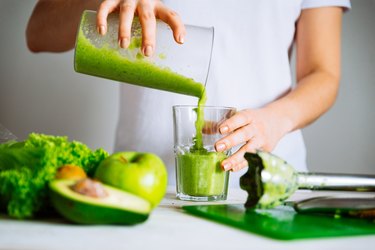
This may not come as a surprise to you, but despite all of mom's harping when we were younger, more than 90 percent of us still don't eat enough vegetables on a daily basis, according to a November 2017 Centers for Disease Control report.
This is concerning (and frustrating) when you consider all that we know about vegetables and how good they are for our health and even our economy and planet. The American Heart Association sums it up nicely:
Video of the Day
Video of the Day
"Higher fruit and vegetable intakes might even benefit the health of our economy and our planet, according to the 'triple bottom line' perspective. This boils down to at least 39,900 avoided deaths, 2.2 million fewer illnesses, 400 million tons of avoided greenhouse gas emissions and more than $7.6 billion per year in healthcare savings in the United States alone."
So if we know veggies are so good for us, why do we continue to fall short?
Myth #1: "Veggies Are Expensive"
One barrier we hear often is that they're expensive. When you look at how cheap junk food can be (like an entire fast food meal for a few bucks or a snack bag of chips for 40 cents), vegetables and fruit can seem pricey. But the truth is, you can meet your daily needs of fruits and vegetables for about $2.10 to $2.60 per day, or about $18 a week, according to a June 2019 USDA analysis.
While this is still a stretch for some families who struggle with food insecurity, this daily dollar amount is probably less than most people think.
Myth #2: "They're Hard to Prep"
Another barrier to eating vegetables is that consumers don't know how to prepare them. They're sick of salads and are tired of sautéing [insert any veggie here] with salt and pepper, but don't have ideas of other ways to incorporate them into their diet.
The first step is to think outside of the box. Don't always think of "eating your vegetables" as having to prepare a side dish to pair with the main entrée, or a pre-dinner salad or entrée salad for lunch.
We asked dietitians to share some of the creative ways they meet their vegetable quota each day. We've got you covered from breakfast through dinner. Pick a few of these that seem doable for you and try incorporating them into your weekly menu rotation.
1. Rely on Half-Homemade Meals
Sometimes, whipping up an entire meal can be overwhelming and/or there just isn't enough time. A solution for this is taking a healthier pre-made meal like a can of low-sodium soup or chili, or a prepackaged dinner like Amy's Sweet and Sour Bowl or Evol's Boost Bowl, and adding more vegetables to it.
Adding cooked carrots and peppers to chili or broccoli to either of these bowls bumps up the nutrition and volume of the meals without having to think about putting together an entire meal.

2. Try Veggie Breakfast Oats
Oatmeal is a great base for breakfast and you can customize it to whatever you're in the mood for — savory or sweet.
"If you're going the savory route, try folding in riced butternut squash, shredded zucchini or pumpkin purée," shares Brierley Horton, RD, a dietitian based in Birmingham, Alabama.
"You could even mimic a zucchini bread and pumpkin bread or pie flavor if you wanted to go sweet." Another option: Frozen riced cauliflower is an easy-add in that can go either sweet or savory, depending on what else you want to add.
Oatmeal Recipes to Try
3. Make Vegetable Vessels
Use actual vegetables as a vessel for the meal. These are especially fun if you have kids or if you're hosting a dinner because the presentation is on point.
"We know spaghetti squash can be used in place of spaghetti, but serve it up, sauce and all, in the actual spaghetti squash shell," says Amanda Kirpitch, RDN, CDN, a nutrition and diabetes educator at Nutrition Perspective.
"You can also hollow out a bell pepper and add meat or vegetarian fillings and then bake until tender. Or, serve up zucchini boats (zucchini cut lengthwise and hollowed), filled with a protein of your choice (ground chicken or beef, or go plant-based with tofu crumbles or beans) and then pair with tomatoes, onions and peppers and top with cheese or breadcrumbs."
4. Try Meat-y Vegetables
Some vegetables, like eggplant and mushrooms, make great swap-ins for meat. They both have a tender meat-like texture and offer savory flavor, too.
If you eat meat, try half ground beef, half chopped mushrooms when making a meat sauce or a burger. You can add eggplant in place of meat for a Bolognese sauce or cube it for kebabs or even slice it lengthwise for eggplant steaks.
5. Go for Halfsies With Cauliflower Fried Rice
Fried rice is delicious but it's also light on the veggies despite the smattering of peas and carrots.
"You can bump up the vegetable offerings by using half regular rice and half riced cauliflower," Horton tells us. Sure, you could go all the way and eliminate all of the rice but it holds up nicely going half-and-half and it makes the meal more filling.
Fried Rice Recipes to Try
6. Embrace Stir-Fridays
There's Meatless Mondays and Taco Tuesdays but have you tried Stir-Fridays? Stir-fries are obviously an easy way to add vegetables to your meal but they can also be an easy way to clean out your fridge before the weekend.
Start with your protein — tofu or chicken work well — and then add any chopped veggies you have on hand. Have leafy greens to use up? Add those right at the end, leaving on the stove for a minute or two.
Stir-Fry Recipes to Try
7. Add Vegetables to Your Salad
No, we're not talking about a leafy, green salad — but instead, adding vegetables to your tuna or egg salad. When making tuna or egg salad, try adding chopped celery and onions.
Fresh herbs like dill or chives are also great because they add freshness and are nutrient-dense.
This recipe for 'Macaroni' Salad combines hearty squash with a creamy dressing for a healthier version of mac salad.
8. Always Have a Bag of Spinach on Hand
Spinach can be added to anything and buying the pre-washed bagged type, makes it even easier to incorporate it into meals.
"I just throw a handful of spinach in for all sorts of things, like microwaved on top of pasta or even raw on nachos," shares Michelle Dudash, RDN, a chef and nutritionist. "You can also add it to canned soups, tossed into sautéed veggies for pasta or rice."

9. Blend Fruit and Veggie Smoothies
Fruit smoothies can be nutrient-packed but they can also be high in sugar, albeit natural sugar, depending on how they're made. Try adding a serving of vegetables to your next smoothie.
"Spinach blends nicely and avocado gives your smoothie a creamier texture," Horton shares. "Carrots also go nicely with fruit. All of these work well and you won't end up with a too vegetal-tasting smoothie."
Smoothie Recipes to Try
- Centers for Disease Control: "Disparities in State-Specific Adult Fruit and Vegetable Consumption — United States, 2015"
- American Heart Association: "CDC Report Reaffirms Importance of Eating More Fruits And Vegetables"
- American Heart Association: "Helping Americans Eat More of the Good Stuff"
- United States Department of Agriculture: "Americans Still Can Meet Fruit and Vegetable Dietary Guidelines for $2.10-$2.60 per Day"